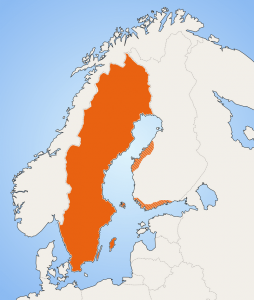History of Swedish
The languages, spoken nowadays in Scandinavia, developed from the Old Norse language, which was pretty much the same in the areas of present-day Denmark, Norway and Sweden. Viking merchants spread the language across Europe (including settlements in present-day Russia), having made Old Norse one of the most widespread languages of their time. Three continental Scandinavian languages (Swedish, Danish and Norse) remained nearly one language until about 1050, when they started to split. Later, they were greatly influenced by Low German.The standard written language of the Swedish state developed from the Svealand and Götaland dialects. The early formation of Swedish can be referred to the age of Magnus II Eriksson (14th century). The contemporary colloquial Swedish language appeared later, along with the 19th century industrialization and beginning of radio broadcasting in 1920s. The standardized effect of radio and television coexist with the influence of regional varieties of Standard Swedish.
Standard Swedish
 Standard Swedish (called in Swedish rikssvenska or, sometimes, “high” — högsvenska) is the most popular Swedish variety, developed from the dialects of Stockholm and its surroundings. It is a language of mass media (however, newsmen often speak with a strong regional accent), taught in schools and understood by the majority of Swedes. However, some Swedish dialects may differ so much, both in terms of pronunciation and grammar, that they are not intelligible to foreigners. The majority of Swedes in Finland can speak Standard Swedish too. Many regional varieties of the standard language, specific to geographic areas of various size (Swedish regions, provinces, cities, villages etc.), are greatly influenced by the Swedish dialects, but their grammatical and phonological structure remains similar to the dialects of Central Sweden.
Standard Swedish (called in Swedish rikssvenska or, sometimes, “high” — högsvenska) is the most popular Swedish variety, developed from the dialects of Stockholm and its surroundings. It is a language of mass media (however, newsmen often speak with a strong regional accent), taught in schools and understood by the majority of Swedes. However, some Swedish dialects may differ so much, both in terms of pronunciation and grammar, that they are not intelligible to foreigners. The majority of Swedes in Finland can speak Standard Swedish too. Many regional varieties of the standard language, specific to geographic areas of various size (Swedish regions, provinces, cities, villages etc.), are greatly influenced by the Swedish dialects, but their grammatical and phonological structure remains similar to the dialects of Central Sweden.Dialects
Many Swedish dialects retained – they are local variations, which avoided the massive impact of Standard Swedish and have had the signs of independent development since the Old Norse period. Many rural dialects – for example, in Dalarna or Ostrobothnia – have pretty noticeable phonetic and grammatical features, such as plural of verbs or archaic case inflection. These dialects may be hardly intelligible to the majority of Swedes.Usually, they are divided into six main groups [1], associated by the common features of prosody, grammar and vocabulary:
- Norrland dialects;
- Finland Swedish;
- Svealand dialects;
- Gotland dialects;
- Götaland dialects;
- South Swedish dialects.
Alphabet and pronunciation
The Swedish alphabet is Latin-based, including the letters Å, Ä, and Ö (listed in such order after the letter Z in the alphabet), as well as É. Before 2006, the letter W was not considered a separate letter but an equivalent of the letter V, and was used only in foreign names and loan words. In 2006, the letter W was added to the alphabet. Despite the wide range of dialects and varieties, written Swedish is unified and standardized.

Stress and accent
Swedish is characterized by the alternative stress in words: stress (dynamic) accent and pitch (musical) accent.Usually, the main stress accent is on the first root syllable.The Swedish dialects, along with the Norse dialects, are often described as “musical”, because of the peculiarities of prosody, which may vary from dialect to dialect. In many dialects, the main stressed syllable in a word can have one or two different pitch (musical) accents:- the first tone (acute, ´, simple pitch accent), falling after a stressed vowel. It is typical for historically monosyllabic words and the majority of foreign words.
- the second tone (grave, `, complex pitch accent), falling within a stressed syllable, then rising in the next syllable and falling again. It is peculiar to polysyllabic words.
- anden [ándɛn] (acute accent) — “duck”
- anden [àndɛn] (grave accent) — “spirit”
- tomten [´tɔmtɛn] (acute accent) — “wasteland”
- tomten [`tɔmtɛn] (grave accent) — “house spirit”
Phonology
Vowels and consonants vary in length, and a stressed syllable always has either a long vowel, or a long consonant.There are 18 consonant phonemes and 17 vowel phonemes in the language (they are slightly different in various Swedish dialects).Vowels
There are 9 long and 9 short vowels in Swedish language. Depending on the length of a vowel different words have different meaning.Front | Central | Back | |||
|---|---|---|---|---|---|
| Unrounded | Rounded | Unrounded | Rounded | ||
Close | i | y | u: | ||
Mid | e | ø | o: | ||
Open-mid | ɛ | ɔ | |||
Open | ɑ | ||||
Consonants
| Bilabial | Labio- dental | Dental | Retroflex /Alveolar | Palatal | Velar | Glottal | ||
|---|---|---|---|---|---|---|---|---|
| Nasal | m | n | ŋ | |||||
| Plosive | voiceless | p | t | k | ||||
| voiced | b | d | ɡ | |||||
| Approximant | v | r | j | h | ||||
| Fricative | voiced | |||||||
| voiceless | f | s | ɕ | ɧ | ||||
| Trill | ||||||||
| Lateral | l | |||||||